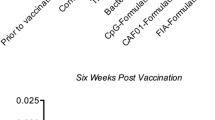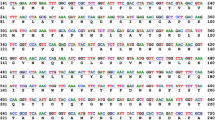Abstract
A genetically attenuated strain of Aeromonas salmonicida has been developed that has a complete deletion of the aroA gene (Brivax II), making it suitable for development as a commercial vaccine. Brivax II was effectively cleared from Atlantic salmon, Salmo salar, a species highly susceptible to furunculosis, confirming that it is attenuated. Clearance rate was dependent on the vaccine dose administered, being longer with higher doses. Immunological studies using Brivax II injected in rainbow trout, Oncorhynchus mykiss, confirmed that live vaccines stimulate a greater response, in terms of generating leucocytes able to proliferate to a subsequent encounter with antigen, relative to killed vaccines. Development of strains of Brivax II as carriers of heterologous antigens was also investigated. Escherichia coli Β-galactosidase was chosen as the model antigen, and three strains containing plasmids with the LacZ gene were constructed (Brivax 12, Brivax 61 and Brivax 107). All three strains were shown to express Β-galactosidase in vivo in rainbow trout and to be cleared effectively. Interestingly, Brivax 107 was cleared faster than the other two Lac+ strains and had the highest level of Β-galactosidase activity. The two strains expressing lower levels of activity also behaved differently in vivo, in that Brivax 12 accumulated derivatives expressing lower levels of Β-galactosidase activity, suggesting that mutants are being selected in vivo. The potential advantages of live vaccines over killed vaccines are discussed.
Similar content being viewed by others
References
Bagdasarian, M., Lurz, R., Ruckert, B., Franklin, F.C.H., Bagdasarian, M.M., Frey, J. and Timmis, K.N. (1981) Specific-purpose plasmid cloning vectors: broad host range, high copy number, RSF1010-derived vectors, and a host vector system for gene cloning in Pseudomonas. Gene 16, 237–247.
Brown, F., Dougan, G., Hoey, E.M., Martin, S.J., Rima, B.K. and Trudgett, A. (1993) Vaccine Design. Wiley: Chichester. 130 pp.
Burkart M.A., Clark, T.G. and Dickerson, H.W. (1990) Immunization of channel catfish, Ictalurus punctatus Rafinesque, against Ichthyophthirius multifiliis (Fouquet): killed versus live vaccines. Journal of Fish Diseases 13, 401–410.
Charbit, A., Martineau, P., Ronco, J., Leclerc, C., Lo-Man, R., Michel, V., O'Callaghan, D. and Hofnung, M. (1993) Expression and immunogenecity of the V3 loop from the envelope of human immunodeficiency virus type 1 in an attenuated aroA strain of Salmonella typhimurium upon genetic coupling to two Escherichia coli carrier proteins. Vaccine 11, 1221–1228.
Dougan, G., Hormaeche, C.E. and Maskell, D.J. (1987) Live oral Salmonella vaccines: potential use of attenuated strains as carriers of heterologous antigens to the immune system. Parasite Immunology 9, 151–160.
Ellis, A.E., Burrows, A.S. and Stapleton, K.J. (1988) Lack of relationship between virulence of Aeromonas salmonicida and the putative virulence factors: A-layer, extracellular proteases and extracellular haemolysins. Journal of Fish Diseases 11, 309–323.
Evelyn, T.P.T. (1993) Bacterial kidney disease — BKD. In: Bacterial Diseases of Fish (eds V. Inglis, R.J. Roberts and N.R. Bromage) Blackwell: Oxford, pp, 177–195.
Kaufmann, S.H.E. (1995) Immunity to intracellular microbial pathogens. Immunology Today 16, 338–342.
Lamers, C.H.J. (1985) The reaction of the immune system of fish to vaccination. Ph.D. thesis, Agricultural University, Wageningen, The Netherlands.
Leong, J.C., Fryer, J.L. and Winton, J.R. (1988) Vaccination against infectious haematopoietic necrosis. In: Fish Vaccination (ed. A.E. Ellis) Academic Press: London, pp. 193–203.
de Lorenzo, V., Herrero, M., Jakubzik, U. and Timmis, K.N. (1990) Mini-Tn5 transposon derivatives for insertion mutagenesis, promoter probing, and chromosomal insertion of cloned DNA in gram negative bacteria. Journal of Bacteriology 172, 6568–6572.
Marsden, M.J., Hamdani, S.H. and Secombes, C.J. (1995) Proliferative responses of rainbow trout, Oncorhynchus mykiss, T and B cells to antigens of Aeromonas salmonicida. Fish and Shellfish Immunology 5, 199–210.
Miller, J.H. (1972) Experiments in Molecular Genetics. Cold Spring Harbor Laboratory: Cold Spring Harbor, New York.
Norqvist, A., Bergman, A., Skogman, G. and Wolf-Watz, H. (1994) A field trial with the live attenuated fish vaccine strain Vibrio anguillarum VAN1000. Bulletin of the European Association of Fish Pathologists 14, 156–158.
Olivier, G. (1990) Virulence of Aeromonas salmonicida: lack of relationship with phenotypic characteristics. Journal of Aquatic Animal Health 2, 119–127.
Rijkers, G.T., Frederix-Wolters, L.M.H. and van Muiswinkel, W.B. (1980) The immune system of cyprinid fish. The effect of antigen dose and route of administration on the development of immunological memory in carp (Cyprinus carpio). In: Phylogeny of Immunological Memory (ed. M.J. Manning) Elsevier: Amsterdam, pp. 93–102.
Simon, R., Preifer, U. and Puhler, A. (1983) A broad host range mobilization system for in vivo genetic engineering: transposon mutagenesis in gram negative bacteria. Biotechnology 1, 784–791.
Thatte, J., Rath, S. and Bal, V. (1993) Immunization with live versus killed Salmonella typhimurium leads to the generation of an IFN-γ-dominant versus an IL-4-dominant immune response. International Immunology 5, 1431–1436.
Thornton, J.C., Garduno, R.A., Newman, S.G. and Kay, W.W. (1991) Surface disorganised, attenuated mutants of Aeromonas salmonicida as furunculosis vaccines. Microbial Pathogenesis 11, 85–89.
Thornton, J.C., Garduno, R.A., Carlos, S.J. and Kay, W.W. (1993) Novel antigens expressed by Aeromonas salmonicida grown in vivo. Infection and Immunity 61, 4582–4589.
Turner, S.J., Carbone, F.R. and Strugnell, R.A. (1993) Salmonella typhimurium δaroA δaroD mutants expressing a foreign recombinant protein induce specific major histocompatibility complex class 1-restricted cytotoxic T lymphocytes in mice. Infection and Immunity 61, 5374–5380.
Vaughan, L., Smith, P. and Foster, T.J. (1990) Aromatic-dependent mutants of Aeromonas salmonicida. Research in Microbiology 141, 941–943.
Vaughan, L.M., Smith, P.R. and Foster, T.J. (1993) An aromatic-dependent mutant of the fish pathogen Aeromonas salmonicida is attenuated in fish and is effective as a live vaccine against the salmonid disease furunculosis. Infection and Immunity 61, 2172–2181.
Verstergaard-Jorgensen, P.E. (1982) Egtved virus: temperature-dependent immune response of trout to infection with low-virulence virus. Journal of Fish Diseases 5, 47–56.
Author information
Authors and Affiliations
Rights and permissions
About this article
Cite this article
Marsden, M.J., Devoy, A., Vaughan, L.M. et al. Use of a genetically attenuated strain of Aeromonas salmonicida to vaccinate salmonid fish. Aquacult Int 4, 55–66 (1996). https://doi.org/10.1007/BF00175221
Issue Date:
DOI: https://doi.org/10.1007/BF00175221




